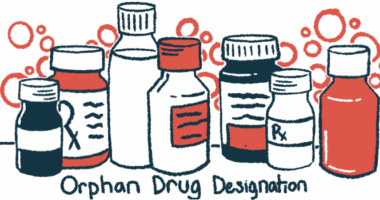PDAC antibody-drug conjugate EBC-129 wins FDA fast track status
Phase 1 trial is testing therapy on 21 people with aggressive pancreatic cancer

U.S. regulators have granted fast track status to the Experimental Drug Development Centre’s (EDDC’s) candidate therapy for pancreatic ductal adenocarcinoma (PDAC), an aggressive form of pancreatic cancer.
The decision by the Food and Drug Administration (FDA) will expedite the development of EBC-129, an antibody-drug conjugate (ADC) that’s being tested for PDAC and other types of solid tumors.
“The FDA’s fast track designation for EBC-129 underscores the promise of this novel ADC in addressing the critical need for expanded treatment options for PDAC patients and represents an important step in our efforts to accelerate its development,” Damian O’Connell, MD, PhD, EDDC’s CEO, said in a a company press release.
The designation will allow the company to engage more frequently with the FDA about plans for the therapy’s clinical development. EBC-129 may also be eligible for priority review and accelerated approval processes, which could help get it through regulatory requirements and make it available for PDAC patients more quickly.
EDDC, Singapore’s national drug discovery and development platform, plans to present updated data from an ongoing Phase 1 clinical trial (NCT05701527) of EBC-129. The presentation, entitled “Clinical activity of EBC-129, a first-in class, anti-N256-glycosylated CEACAM5 and CEACAM6 antibody-drug conjugate (ADC), in patients with pancreatic ductal adenocarcinoma (PDAC) in a Phase 1 study,” will take place at the American Society of Clinical Oncology (ASCO) Annual Meeting in Chicago on June 2.
The most common form of pancreatic cancer, PDAC tends to be aggressive and difficult to treat. This means there is a high unmet clinical need for effective therapies.
Testing EBC-129 on pancreatic cancer
EBC-129 targets a specific site found only on tumor cells, called the N256-glycosylation site, which is shared by the two proteins CEACAM5 and CEACAM6 that play key roles in how tumors grow, spread, and move through the body. This tumor-specific marker has been found in many types of solid tumors, including PDAC.
The antibody portion of the therapy targets these molecules and lets EBC-129 recognize and bind to cancer cells. Its second component, monomethyl auristatin E (MMAE), is an agent that prevents cells from dividing. Although MMAE is too potent to be used on its own, the linked antibody allows it to target cancerous cells. Specific targeting means the drug is more likely to prevent tumor growth and less likely to cause systemic toxic effects. MMAE is already approved with other ADCs.
In the Phase 1 trial, EDDC is testing EBC-129 both alone and in combination with Keytruda (pembrolizumab), an immunotherapy approved for different types of cancers. The study included patients who’d already received other treatments and their cancer was either locally advanced or had metastasized. It was divided into two parts: a dose escalation, that is, finding a safe dose, and a dose expansion to further evaluate effects at selected doses.
At ASCO, Robert Lentz, MD, will present results from the 21 study participants with PDAC, who are an average age of 63. Most had been heavily treated before, with a median of three previous treatments.
EBC-129 was given by an infusion into a vein, or intravenously, once every three weeks at 1.8, 2.0, or 2.2 mg/kg. At the analysis in January, five patients were still receiving treatment, while others had either shown disease progression or stopped for other reasons.
The treatment showed some promising early signs. Tumor shrinkage was seen in 43% of patients overall, and the disease control rate — meaning the cancer didn’t get worse at the first scan — was 87.5% at 1.8 mg/kg and 63.6% at 2.2 mg/kg. On average, patients went 12 to 18 weeks without their cancer progressing, depending on the dose.
The most common side effect was infusion-related reactions, which were seen in 57% of patients, and were mostly mild and more common at the higher dose. The reactions were usually manageable with medication.
The researchers also looked for signs in the blood that EBC-129 was working. A drop of more than 25% in the levels of CEACAM5 and CEACAM6 was seen in 42.9% of patients at 1.8 mg/kg and 36.4% at 2.2 mg/kg. However, there was no clear link between the amount of target protein in the tumor and how well the patients responded.
”EBC-129 shows promising clinical activity in heavily treated PDAC patients with a manageable tolerability profile, consistent with MMAE-based ADCs,” wrote the researchers, who said the trial will continue assessing EBC-129 for PDAC, both alone or with Keytruda.
According to EDDC, fast track designation from the FDA highlights the potential of the therapy. “We view this as both a validation of our efforts and a responsibility to move decisively to advance EBC-129 as a new option to patients in need,” O’Connell said.







